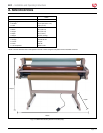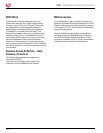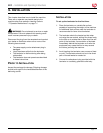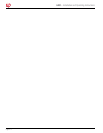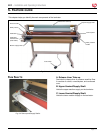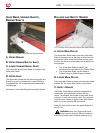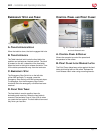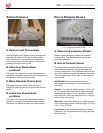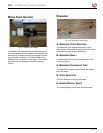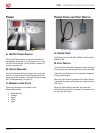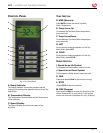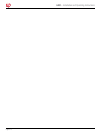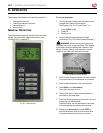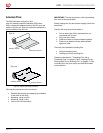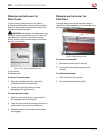
640t – Installation and Operating Instructions
Page 5-4
te n s i o n co n t r o l s
Fig. 5-7. Tension Knobs and Brakes
a. re l e a s e li n e r te n s i o n kn o B
Use the Release Liner Tension Knob to increase and
decrease the amount of Pull that is being applied
to the release liner. This prevents the release liner
from being pulled into the laminator or the lm from
wrapping around the rewind tube.
B. up p e r fi l m te n s i o n kn o B
a n d Br a k e
The Upper Film Tension Knob and Brake allows the
operator to increase or decrease the lm web tension
as needed to reduce curl and wrinkles.
c. me d i a re W i n d e r te n s i o n kn o B
The Media Rewinder Tension Knob allows the
operator to adjust the amount of pull on the nished
media.
d. lo W e r fi l m te n s i o n kn o B
a n d Br a k e
The Lower Film Tension Knob and Brake allows the
operator to increase or decrease the lm or media
web tension as needed to reduce curl and wrinkles.
ro l l e r pr e s s u r e ha n d l e
Fig. 5-8. Roller Pressure Handle.
a. mo u n t i n g & laminating pr e s e t s
Mounting and Laminating Presets are located on
the side cover. The decal describes the gap and
downward pressure.
B. ro l l e r pr e s s u r e ha n d l e
The Roller Pressure Handle adjusts the amount of
roller pressure needed for various laminating and
mounting applications. Pull the handle away from the
laminator, rotate it to the desired pressure, and press
it into the desired slot. Three main function settings
are provided.
IMPORTANT: Use a pressure setting that is
appropriate for the material you are laminating or
mounting.
Release – Provides the widest opening of 1/2 in. (1.6
to 12.7 mm) between the pressure rollers and takes
pressure off the rollers. This is used when installing
new rolls of lm. When the machine is not in use, put
the handle in this position.
Mounting – Used when bonding to a rigid substrate
such as mounting boards. Thickness range is 1/16 to
1/2 in. (1.6 to 12.7 mm).
Laminating – Used to adhere materials in multiple
substrates. The two positions are low (right) and high
(left) pressure.




